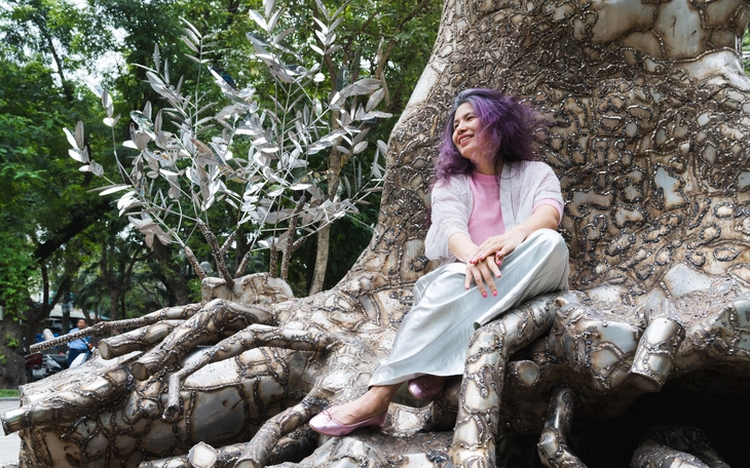
Artist Tia-Thuy Nguyen beside the ancient mahogany tree after its resurrection
The inauguration ceremony of the public art project Resurrection – a renovation of Co Tan Square in Hoan Kiem District – took place in a solemn and celebratory atmosphere.
The event was attended by artist Tia-Thuy Nguyen; Pham Tuan Long, chairman of the Hoan Kiem District People's Committee; Ha Van Sieu, deputy director general of the Vietnam National Authority of Tourism; Vu Dang Dinh, secretary of the Hoan Kiem Party Committee; and others.
"This tree was part of a generation of mahogany trees imported from Africa by the French for urban street planting trials," Long said during the ceremony.
"They are symbolic of a historical period of the capital.
"Resurrection not only creates a creative space for residents and visitors to enjoy every day, but it also pays homage to the trees that have long completed their mission of shading our city – a tribute to Mother Nature."
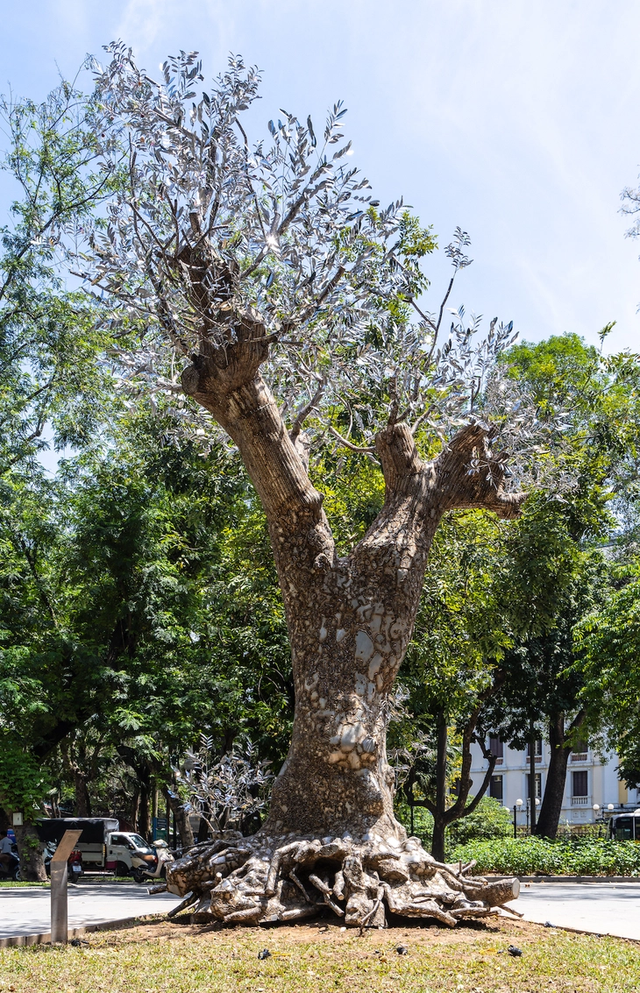
'Resurrection,' a sculpture created from a fallen mahogany tree at Co Tan Square in Hanoi
A contemporary dance choreographed by Meritorious Artist Tran Ly Ly deeply moved the ceremony attendees.
The performance began with broken tree trunks shrouded in mist and the scent of essential oils, then moved through scenes of struggle and collapse before rising again – mirroring the cycle of life, death, and rebirth.
It culminated in an image of leafy canopies reaching skyward – a symbol of vitality at the heart of Hanoi.
Journey of 'Resurrection' of 70-year-old mahogany tree after typhoon Yagi
After Typhoon Yagi hit norther Vietnam in September last year, approximately 25,000 trees fell across Hanoi, many of them decades old.
These losses evoked deep sadness among locals, as trees are not only urban fixtures but emotional markers of Hanoi's soul.
Among the fallen was a 70-year-old mahogany tree in Co Tan Square, by the edge of Hoan Kiem Lake.
During the cleanup, city leaders received a proposal to resurrect the tree into a public artwork at the very spot it once stood.

Amid the lush greenery of Co Tan Square in Hanoi, the shimmering steel canopy of 'Resurrection' stands out.
After over six months of dedication, artist Tia-Thuy Nguyen fulfilled this promise, unveiling the piece on Earth Day, April 22.
Tia-Thuy Nguyen recalled how she rushed to Hanoi after the storm, witnessing the devastation with a heavy heart.
At Co Tan Square, she paused before the felled tree as it was being cut down and instantly decided to take action.
With friends, she began contacting authorities to propose the resurrection project.
After cutting and treating the tree trunk and roots, she meticulously wrapped the trunk in thick stainless-steel sheets, each manually shaped to follow the tree's original curves.
The welds were carefully sealed, forming textures reminiscent of natural bark.
Branches were sculpted with organic, twisting lines.
The canopy was made from thousands of glimmering steel leaves and adorned with sparkling quartz 'flowers' in radiant colors.
Over six tonnes of steel were used to construct the trunk, branches, and canopy – designed to catch and reflect sunlight.
The varying sunlight of Hanoi's four seasons makes the installation ever-changing, mirroring the diversity of life and the multifaceted nature of the universe.
This symbolism lies at the heart of Tia-Thuy Nguyen's artistic message.
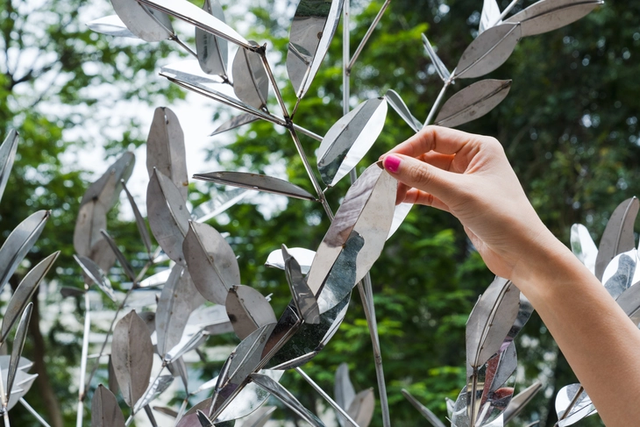
The canopy is crafted from thousands of gleaming steel leaves.
Artwork resonating with deep meaning
The unveiling drew a large crowd of locals and tourists alike.
Many were astonished at how a fallen tree had been reborn in such an imaginative and meaningful form.
Visitors, both domestic and international, took the opportunity to admire and photograph the work, celebrating the harmony between nature and human creativity.
During the ceremony, Tia-Thuy Nguyen expressed her heartfelt gratitude to her collaborators.
From those who shared insights into the tree's life, to those who helped present the project, offered creative feedback, or worked beside her – welders turned artisans – every contribution helped shape the final piece.
She also acknowledged the construction workers, cleaners, guards, local police, rickshaw drivers, and residents who offered stories of the land and its people.
Especially touching was her tribute: "My deepest thanks go to my father, who is no longer with us but taught me about loss and pain – lessons that helped shape Resurrection. Thanks to my mother, who visited the site daily to check on the workers. Above all, I give thanks to Mother Nature. She placed no obstacles in our way and now gifts us sunlight that brings this work to life. History, memories, and myths of this place have given the piece a soul."
She concluded: "The warm reception from the community is not just a personal success – it's a collective achievement. The joy and wonder this work brings has left an indelible mark on my heart, and I hope it continues to spread happiness to everyone who visits."
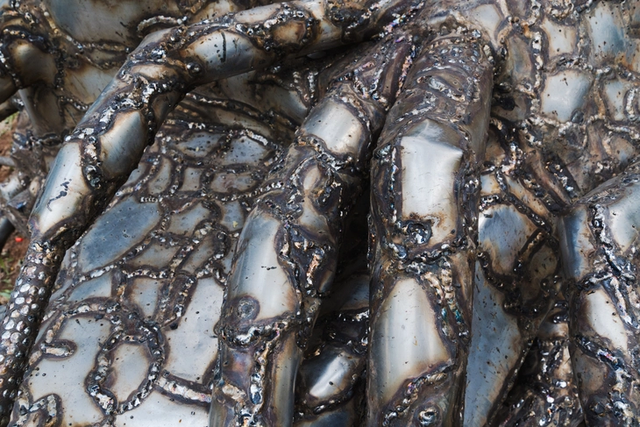
The trunk is clad in thick, hand-hammered stainless steel panels.
Landmark for public art in Vietnam
A question many in the art world asked is how Tia-Thuy Nguyen secured approval for this unique project? With transparency and openness, she and her team shared the journey of navigating permissions and receiving strong support from government departments.
Vu Hoang Quyen, development economist and one of the first to explore post-storm Hanoi with the artist, connected her with Hoan Kiem District leaders.
Upon hearing about the idea, chairman Long personally visited the site with officials to assess and guide the project.
It took three months to prepare documentation and collaborate with different authorities to obtain full permission.
Quyen emphasized this was not long, considering the project's complexity, the need for safety, harmony with the landscape, and meaningful content.
Pham Quoc Tung, marketing director of Davines Vietnam, commented: "In recent years, public art has been blossoming in Vietnam. Resurrection, with its transparent project planning, sets a precedent for other artists to navigate and create urban artworks more easily."
Quyen added that contemporary public art not only brings cultural value but also significant economic impact.
"Studies over the past 50 years has showed that public art boosts local business and tourism," she said.
"One U.S. study found that for every dollar a patron like Thuy invests in art, it can generate $1.50 in economic activity over five years.
"It also increases pedestrian activity and encourages a slower, more mindful pace of life – ultimately improving public health, which contributes to the economy."
Architect and community development expert Doan Ky Thanh concluded: "This is a groundbreaking step for public art in Vietnam. Until now, we've lacked true public art projects – works that belong to the community. This may well be one of the first that truly serve the people through art."
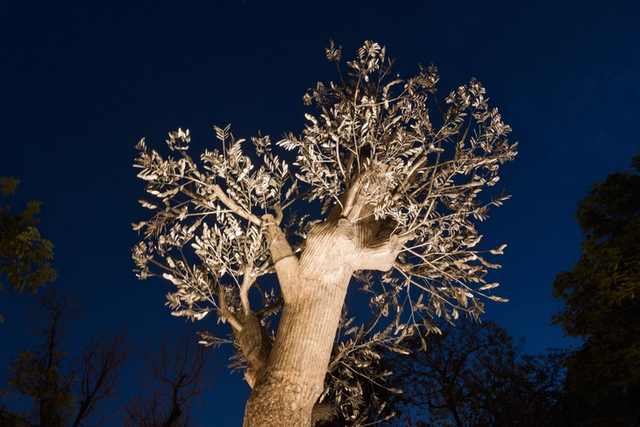
'Resurrection' continues to shine through the night.
Resurrection does not merely tell the story of one mahogany tree. It tells the story of Hanoi – of those who lived, lost, and found a way to stand again after the storm, like the people of this city.
Chairman Long, who played a pivotal and heartfelt role in bringing the project to life, shared: "I hope this work, and the spirit it carries, will receive wholehearted support from everyone. Let us preserve it together, and 'live' with it in the most respectful, meaningful way possible."
Resurrection is located at Co Tan square, beside Hoan Kiem Lake.
This large-scale outdoor installation is freely accessible to the public.
The artist hopes that each visitor will feel free to enjoy the beauty of the tree in natural light and find their own quiet reflections within it.


Max: 1500 characters
There are no comments yet. Be the first to comment.